The name volcano comes from an island called Vulcano, which is just to the north of Sicily in Italy, and it's part of a group of islands called the Aeolian Islands. It includes other famous volcanoes like Stromboli. At a crucial point in time, a volcano erupted and made a big impression, so the name volcano is imprinted in many European languages as the generic name for volcanoes.
The power of volcanoes
Professor of Earth Sciences
- The word ‘volcano’ derives from Italy’s Vulcano island, near Sicily, whose ancient eruptions branded the word across Europe.
- The Pele legend mirrors Hawaii’s island-by-island growth, a myth that matches real geology.
- Plinian eruptions, named after Vesuvius AD 79, shoot ash-gas columns skyward before they mushroom out like umbrellas.
- Tambora and Krakatoa lofted sulfur that cooled the climate and reddened sunsets, yet humans now emit CO₂ about 60 times faster than all volcanoes combined.
The word ‘volcano’

View of the northern profile of Vulcano from the island of Lipari © Wikimedia
Volcanoes in mythology
There are many local gods associated with volcanoes around the world. A very famous example is Pele in the Hawaiian Islands. What's really beautiful about the legend of Pele is that she arrives at the Hawaiian Islands, moves from the older land to the newer land and is based in the present day to reside in the Halema'uma'u crater, which is on Kilauea, the most active of the Hawaiian volcanoes. The legend of Pele follows the actual geology in terms of the Hawaiian Islands getting younger as you move towards Kilauea. It's a lovely example of the way that legend can, in some ways, resonate with what we know scientifically.
Volcanic myths and literature
Our understanding of volcanoes as a species has really been an incredible journey. In Roman times they had experience of volcanoes; Vesuvius wiped out Pompeii and Herculaneum in AD 79.
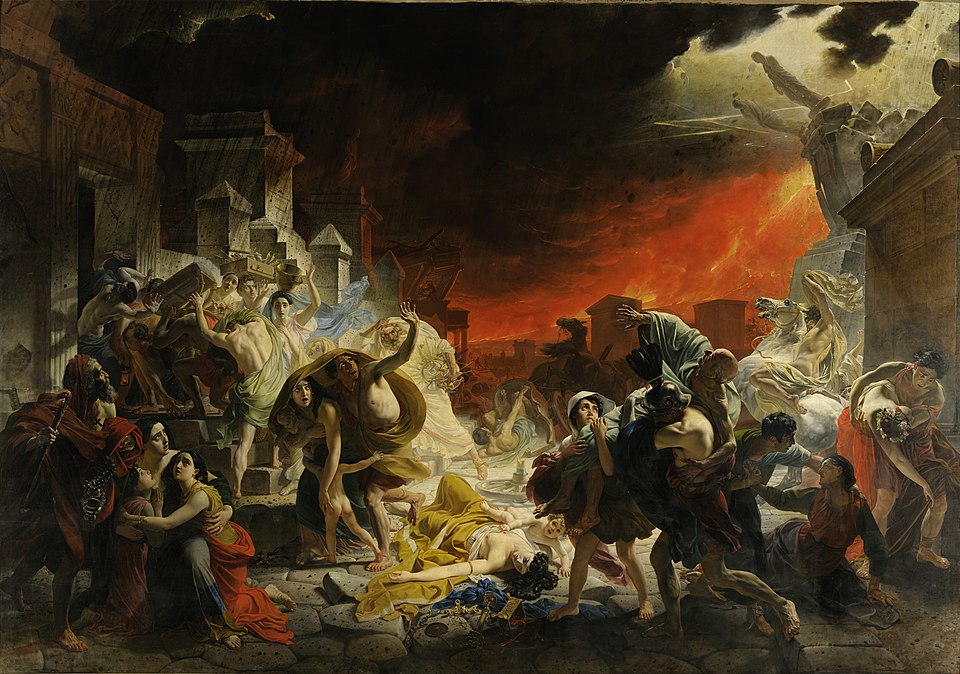
The Last Day of Pompeii © Karl Bryullov, State Russian Museum, St. Petersburg via Wikimedia
There is a very famous account of Pliny the Younger about that eruption. Volcanoes like Etna and Stromboli are in Sicily, Italy, and Santorini, Greece, and there are other volcanoes in the Mediterranean area. The classical idea of volcanoes was a lot about Earth's internal fire. Volcanoes were thought to be the chimneys through which the Earth's internal fires vented, or, in some cases, where the gases heated up because of friction and similar phenomena. As the medieval period adopted these ideas, they were merged with those of hellfire as well. In places such as the Masaya Volcano in Nicaragua, there is still a cross on the crater rim that was first erected by the conquistadores when they arrived from Spain. It was supposed to keep the evil spirits, the back door to hell, under control in terms of stopping escape from the volcano's evil vent. For many years people associated volcanoes with burning, with combustion. It was a big discovery to look at what we still call volcanic ash, compare it to the ash from combustion fires and to realize they were quite different. Moving from that to more scientific ideas, people realized this is a different phenomenon; although they visually look very similar, red-hot rock results in the phenomenon of volcanic eruptions, rather than something that's burning like embers in a fire.
Volcanism and Earth's layers
Understanding volcanoes has been woven together with understanding the structure of the Earth. Most of us spend our lives walking the surface of the planet with no real direct experience, unless we go into mines, of what goes on beneath our feet. We have to piece evidence together. We learn a lot about the Earth's internal structure from seismic waves. When a big earthquake occurs, it can cause enormous damage and be incredibly tragic, but it also gives us really interesting information; we can look at the way the different waves travel through the Earth. In the simplest case, some waves are similar to sound waves. We also have waves that more resemble a Mexican wave going around a stadium. The sound or pressure waves can travel through solids and through liquids, whereas the other waves can travel only through solids, because they need to have the atoms pulled back in. By looking at the way these waves travel through the Earth, we're able to understand more about the layers of the Earth.
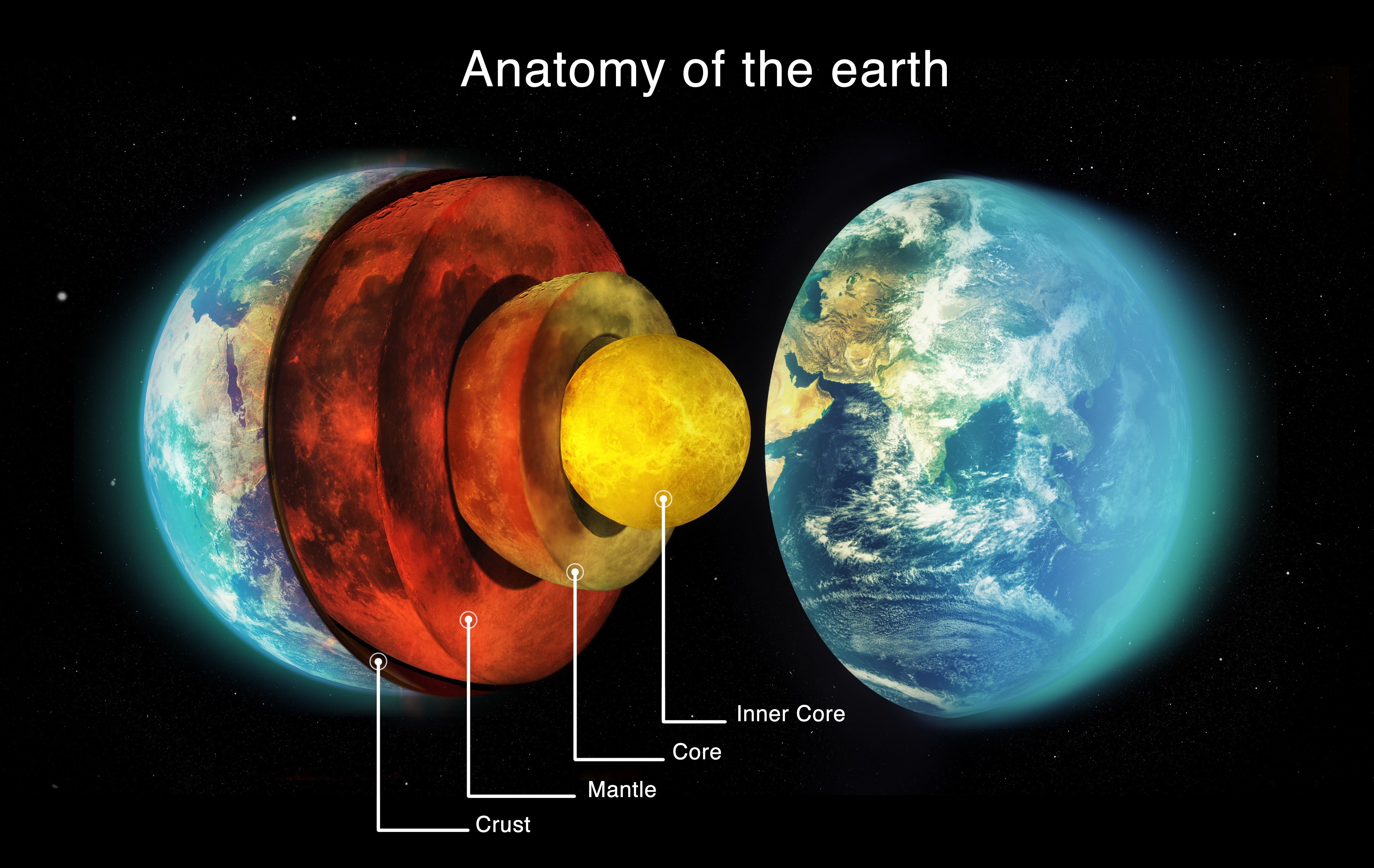
© Wikimedia
We understand that we first have the crust, which is solid, which is what we live on and what we're most familiar with. Then, we have a layer called the mantle, which is also solid but actually creeps very slowly, at about the same speed as your fingernails grow, despite being solid. Beneath that, we have the liquid outer core and then the solid inner core. All this amazing information has come to us through studying the signals we can see at the surface and sometimes the rocks that come to the surface. The key is that to get magmas, to get liquid rock or lavas, special things need to happen inside the Earth that melt the mantle and create these liquid magmas.
Plinian eruption columns
Plinian eruption columns are a really fascinating phenomenon. They're named after the account of the AD 79 eruption of Vesuvius by Pliny the Younger – the eruption that wiped out Pompeii and Herculaneum. Pliny the Younger and his uncle, Pliny the Elder, were staying around the Bay of Naples and were able to see the events unfolding. Pliny the Elder set off on a rescue mission to the people affected by the eruption and subsequently died, potentially of asphyxiation associated with asthma, or possibly a heart attack brought on by the volcanic fumes during the rescue mission. Pliny the Younger then wrote two letters describing what happened and describing this phenomenon, which is like an umbrella pine: It has a strong trunk and then spreads out at the top. We now understand much more about the science of this: When a volcanic explosion drives such an eruption, there is a ballistic path, similar to rocks being fired out of a gun or a cannon; they're fired upwards but are sufficiently heavy that they would not get very high if that was the only factor.
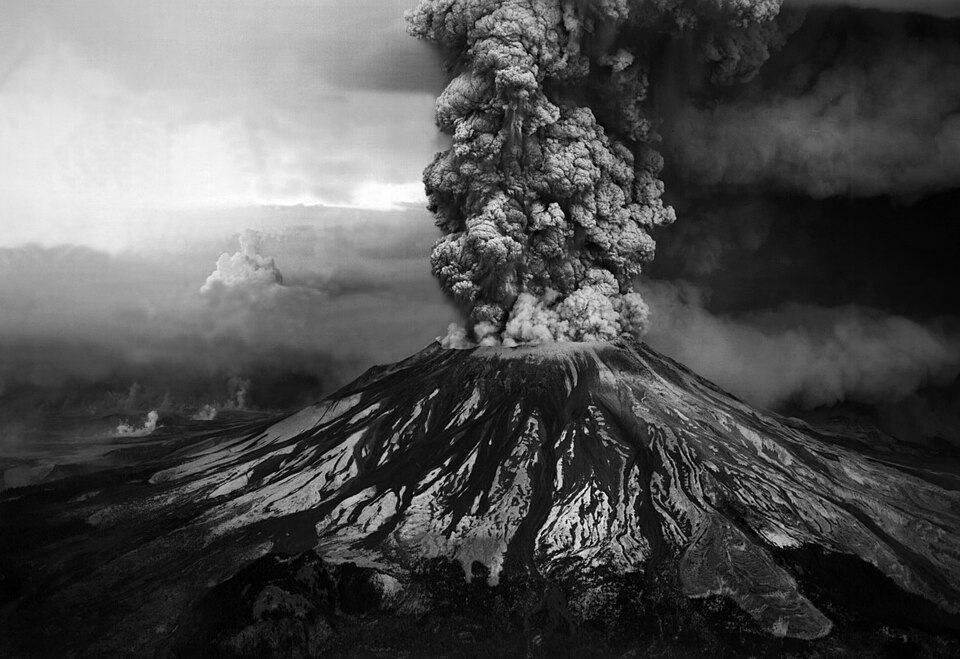
Eruption column © U.S. Forest Service- Pacific Northwest Region via Wikimedia
They're also very hot. The volcanic plume, a mixture of gas and ash, mixes with the surrounding atmosphere, heats it up and then results in a massive convection column. Hot air rises, because it's less dense than the surrounding atmosphere. Eventually, it reaches a point of neutral buoyancy, overshoots and then spreads, giving the very characteristic umbrella shape at the top called the umbrella region.
Types of lava flows
Lava flows come in all sorts of different types, but often the ones that make the most spectacular pictures are these so-called basaltic flows: they are quite fluid and flow relatively freely. They have a low viscosity, in more technical terms. They can be very liquid flows, or quite blocky flows that we call "ʻaʻā", a Hawaiian word – or they can go in lobes and inflate themselves, which we call "pāhoehoe" flows – another Hawaiian word. Standing next to a lava flow is an incredible experience. You can smell the volcanic gases. There may be a mixture of a rotten-egg or burnt-matches smell; those are the different sulfur gases. There might be a clinking sound, which is the way the flow sounds when it is moving along. If there are explosions, there might be vibrations coming through the ground as well. Of course, close to the flow, it's incredibly hot, about 1,000°C. At night, the whole landscape will be black with red breakouts where the crust of the lava is broken.
Volcanoes transforming landscapes
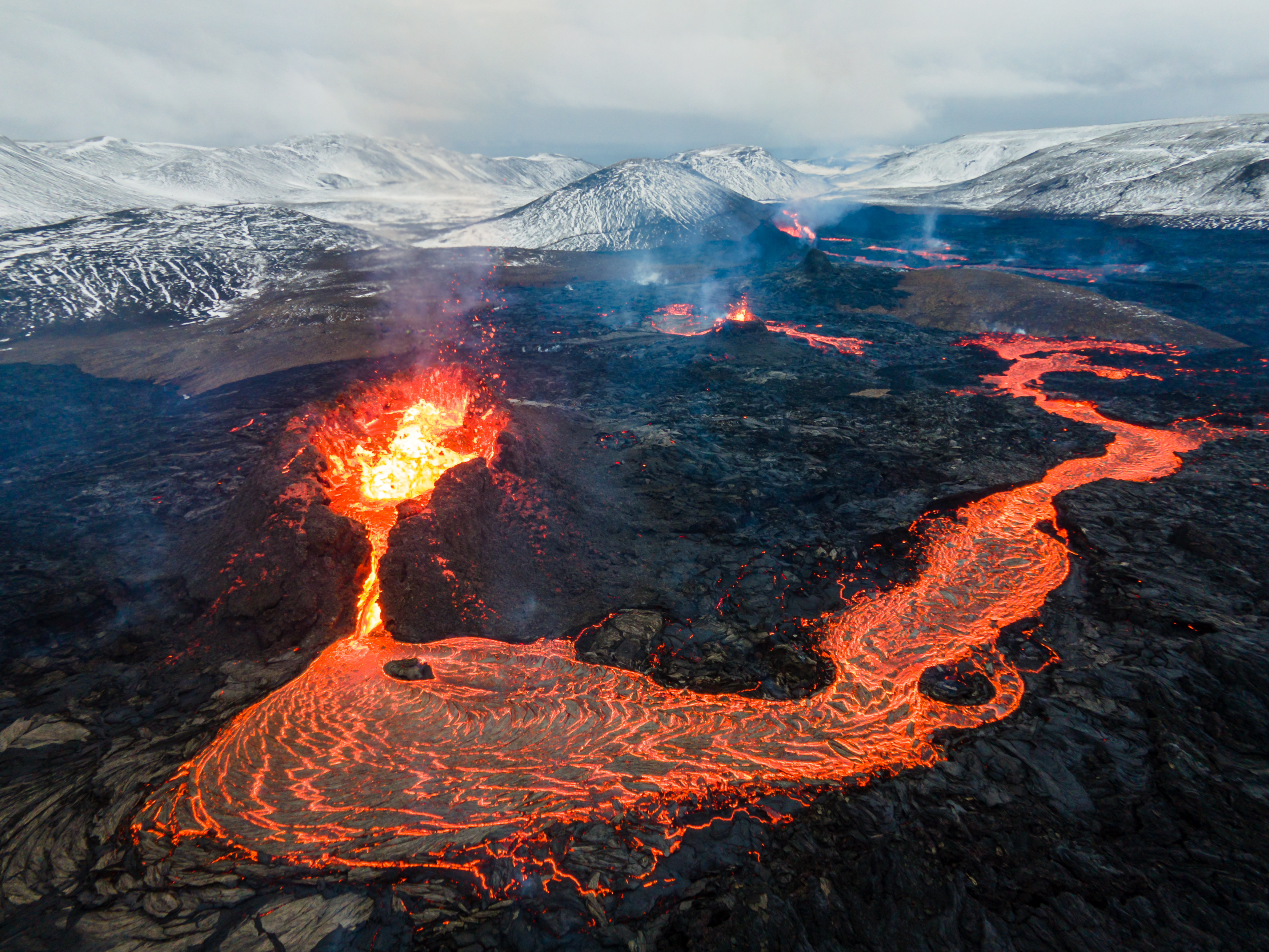
Lava Flows on active volcano, Mount Fagradalsfjall, Iceland © ImageBank4u via Shutterstock
Volcanoes have the potential to completely rewrite a landscape. Lava flows will overflow local vegetation and burn it. Hollows sometimes appear in lava flows where the lava has flowed and then burnt a tree out of itself, leaving an imprint behind. Often, the air quality is worse because the lava flows are moving over moss or other vegetation, and the burning vegetation adds to the pollution that the volcanic gases are causing. A really explosive eruption can scatter ash and other debris over a wide area so that it completely mantles the whole topography. Sometimes it's described in Pliny and other accounts as being almost like a snowfall event, where the whole landscape has been cloaked in volcanic ash. The rewritten landscape, to begin with, will seem to be completely devoid of vegetation and animals.
Powerful natural phenomena
Volcanoes are a manifestation of Earth's inner energy. Inside the Earth, it's very hot. Some of that heat is actually primeval heat retained from when the Earth was formed, when it accreted, when it came together from the different building blocks. Some of that heat is from the radioactive decay of different atoms and different isotopes within the Earth over geological time.

Pyroclastic flow descending down Tar River Valley, Soufriere Hills Volcano, Montserrat, Caribbean, January 2010; © Photovolcanica.com via Shutterstock
There is a significant amount of heat and energy inside our planet, and volcanoes are the manifestation of that. That plays out in many ways, in terms of the heat that drives explosive eruptions, but also the gases that are dissolved inside magmas. When the gases come to the surface, they come out of solution. It is similar to opening a fizzy drink and hearing the hiss; if it has been shaken up, sometimes it is explosive. The gases come out of solution. Bubbles are forming, and they get bigger and bigger. When they reach the surface, they may be so big that the magma cannot contain them anymore, and a massive explosion results. Many different things drive volcanic power.
Krakatoa and vivid sunsets
Massive volcanic eruptions like Krakatoa in 1883 have the ability to blast enormous quantities of material into the stratosphere. The stratosphere is the layer of the atmosphere above the troposphere, where the ozone layer is. One of the key things about the stratosphere is that once things reach it, it is much more difficult to get them down. It doesn't circulate in the way the troposphere does, and it doesn't have weather to rain things out, so things get stuck in the stratosphere for much longer periods. After a big eruption like Krakatoa, sulfur dioxide remains in the stratosphere; it is the gas that smells a bit like burnt matches. It chemically changes; it oxidizes over a period of a few years to form a fine aerosol veil of very small particles. What happens is the stratosphere becomes hazy. It creates a hazy day, a misty day, but that means that it reflects light in different ways.
It reflects more of the sun's energy back out into space, which has a tendency to cool down the lower atmosphere. If you picture sunsets and the artistic nature of sunsets, this aerosol, these tiny particles up in the stratosphere, can make sunsets more vivid; they can make them redder and change the color palette of the sunsets or make them even more impressive. As the sun sinks below the horizon, you get more light bouncing off these little particles and bouncing down, so you get a much longer afterglow. After sunset, light remains for much longer. This was observed after Krakatoa, and some observers were quite obsessed by it.
Documenting Krakatoa's impact
After the Krakatoa eruption, the Royal Society pulled together lots of accounts of the atmospheric phenomenon and the pressure-wave measurements as well. Krakatoa is interesting, because it was in many ways the first global volcanic eruption. It was the first time telegraph cables were laid under the ocean, so it was the first time that news had the potential to travel around the planet essentially at the speed of electrical signals. People knew about the Krakatoa eruption very rapidly. There was an enormous and tragic loss of life locally in Indonesia, but people were afterward on the lookout for changes in the atmosphere and had barometers in different places around the globe. They were able to see the pressure wave traveling around the planet, possibly up to about seven times. People were on high alert about Krakatoa.

The Eruption of Krakatoa, and Subsequent Phenomena © William Ashcroft, Report of the Krakatoa committee of the Royal Society (1888), ed. by G.J. Simmons via Wikimedia
The Royal Society gathered lots of these accounts of the eruption and other phenomena around it into a large volume, and at the front of the volume are some paintings by an artist called William Ashcroft, who painted hundreds of examples of the vivid sunsets seen in London from the Chelsea Embankment. Some of them are depicted in the front of this volume, which was a significant discovery when I opened it up for the first time.
Tambora and the “year without a summer”
The Tambora eruption happened in 1815 in Indonesia, and the year after the Tambora eruption is sometimes referred to in more modern times as the year without a summer. Plenty of evidence from the time shows that people realized they were having very atypical weather. There was snowfall in New England; there was a big disruption to harvests in Europe; and there are accounts of rioting in France. In Switzerland, people were forced to eat moss and their pets. The weather was terrible.
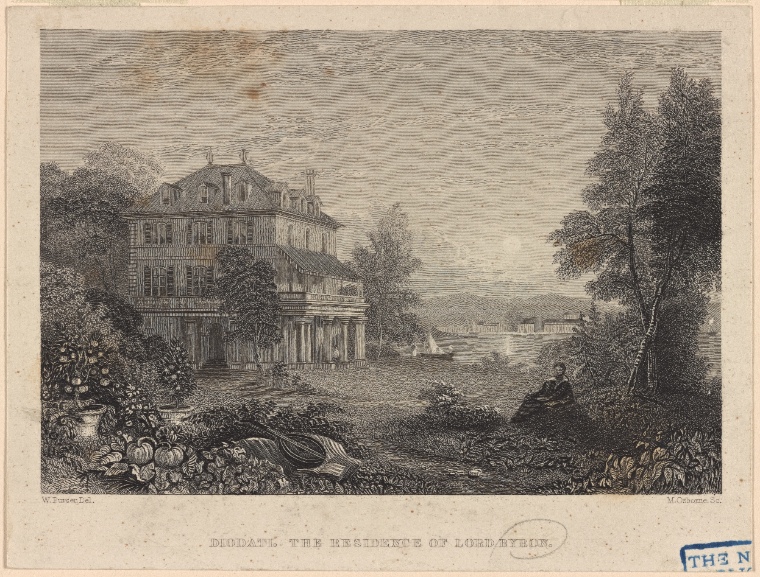
Diodati, the residence of Lord Byron © Carl H. Pforzheimer Collection of Shelley and His Circle (1833); The New York Public Library via Wikimedia
Mary Shelley and Lord Byron, who were on holiday by Lake Geneva, could not get out and about, and they entertained themselves by writing poetry – for instance, Byron’s poem “Darkness” – and then Mary Shelley came up with the idea for what would become Frankenstein. There is a great deal of evidence for the disruption of the weather, and the cause was the sulfate aerosol veil. The sulfur dioxide had been thrust into the stratosphere, where it tends to linger, and it chemically changed, or oxidized, into these fine sulfate particles. That fine, hazy layer circling the planet reflects the sun’s rays back into space and cools the atmosphere, and it disrupts global weather patterns. We witnessed this more recently, after the 1991 Pinatubo eruption in the Philippines. In 1991, we were able to understand and study it in much more detail, because we have global satellite observations. We can really try to get to the heart of what is going on scientifically.
Volcanoes regulating climate
Sometimes people think of volcanoes as being very destructive, but one thing that really inspires me about volcanoes is how important they have also been for the development and maintenance of our beautiful, habitable planet. As far as we know, this planet is unique in the universe. It may turn out not to be the case, but what we understand now, in terms of hosting life, and for complex life like ourselves to evolve, we have needed a degree of stability of the climate, and volcanoes play a key role in that. In our atmosphere, we have carbon dioxide. We have learned a lot about that recently, and we know about its negative effects, but we do need some carbon dioxide in our atmosphere; otherwise, the planet would be incredibly cold.
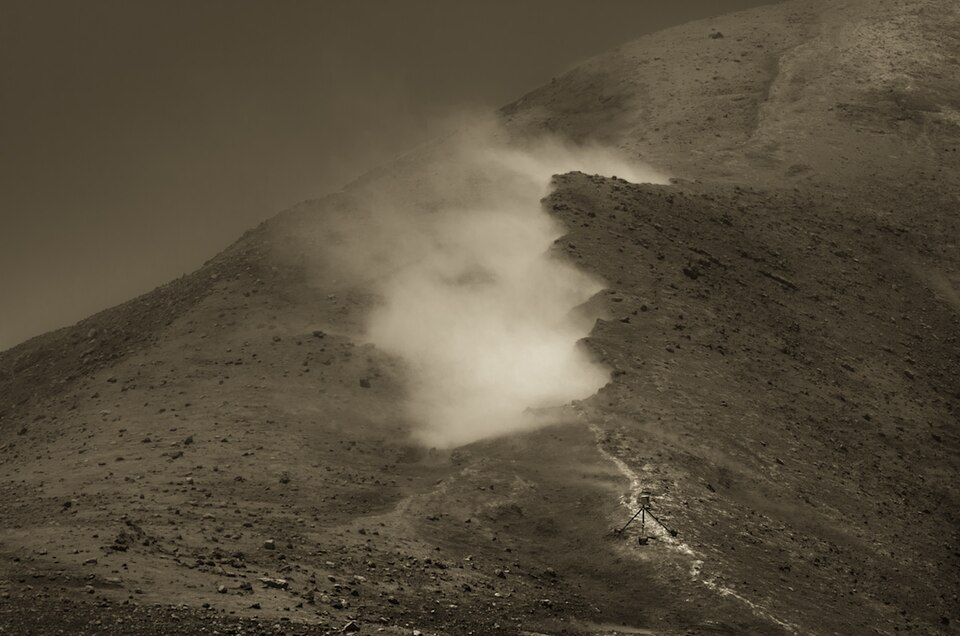
Fumarole field, Mount Etna Volcano © UCL Mathematical & Physical Sciences via Wikimedia
Some of the greenhouse effect is really important to keep Earth warm enough, and volcanoes emit a lot of carbon dioxide (though not as much as we do at the moment). That is part of this system of balance. Volcanoes release carbon dioxide in their emissions, balanced by natural processes that take carbon dioxide out of the atmosphere during rainfall, and then it reacts with rocks in something called chemical weathering. Then it gets drawn down into the oceans. If the planet gets hotter, that weathering rate increases and pulls carbon dioxide out of the atmosphere, so the planet cools down. If the planet gets colder, the weathering rate decreases, so carbon dioxide builds up in the atmosphere. What we actually have is our very own thermostat. It operates over very long geological timescales and has been particularly effective over the last 500 million years because of the biology involved, but it is a wonderful example of how our planet’s natural cycles, within certain bounds, are balanced. Volcanoes play a key role in that.
Volcanoes and responsibility
I think we can learn a lot from volcanoes in terms of the current climate crisis and uncertainty. If we think about the natural cycle of carbon-dioxide emissions, the rate at which volcanoes are putting carbon dioxide into our atmosphere at the moment gives us a benchmark that we can compare ourselves to, and the evidence suggests humankind is emitting carbon dioxide at about 60 times the rate of the world’s volcanoes.
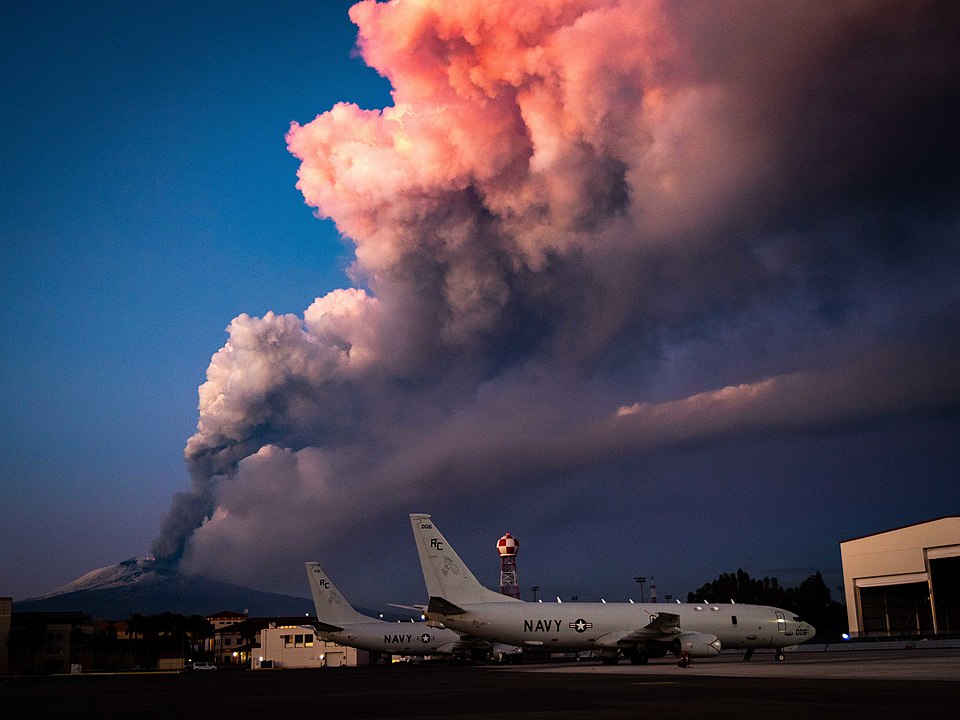
Mount Etna erupts near Naval Air Station Sigonell © Official U.S. Navy Page via Wikimedia
We are really beating volcanoes. This gives us a benchmark by which to judge ourselves in terms of how much we are changing the system, how much we are perturbing it. If we look back deeper in time, into the greatest episodes of volcanism, referring to large igneous provinces – which are incidences when, for about a million years, the rate of volcanism on the planet doubled because of large outpourings of basalt onto the surface – we can study the environmental consequences of them in the geological record, and they are pretty dire. The Big Five mass-extinction events – at least three of them, and probably four – correlate in time with these great outpourings of volcanism, which potentially doubled the rate of carbon-dioxide emissions to the atmosphere. We are emitting carbon dioxide at about 60 times the rate of volcanoes, so it is a big warning. It is another piece of evidence suggesting that we must grapple with our global responsibility as a species to try to minimize the impact we are having on our atmosphere and environment.
Editor’s note: This article has been faithfully transcribed from the original interview filmed with the author, and carefully edited and proofread. Edit date: 2025
Discover more about
the importance of volcanoes
Mather, T. A. (2024). Adventures in Volcanoland: What Volcanoes Tell Us About the World and Ourselves. Abacus.
Mather, T. A., & Pyle, D. M. (2015). Volcanic emissions: short-term perturbations, long-term consequences and global environmental change.. In A. Schmidt, K. E. Fristad, & L. T. Elkins-Tanton (Eds.), Volcanism and global environmental change (pp. 208–227). Cambridge University Press.
Pyle, D. M., & Mather, T. A. (2003). The importance of volcanic emissions for the global atmospheric mercury cycle. . Atmospheric Environment, 37(36), 5115–5124.